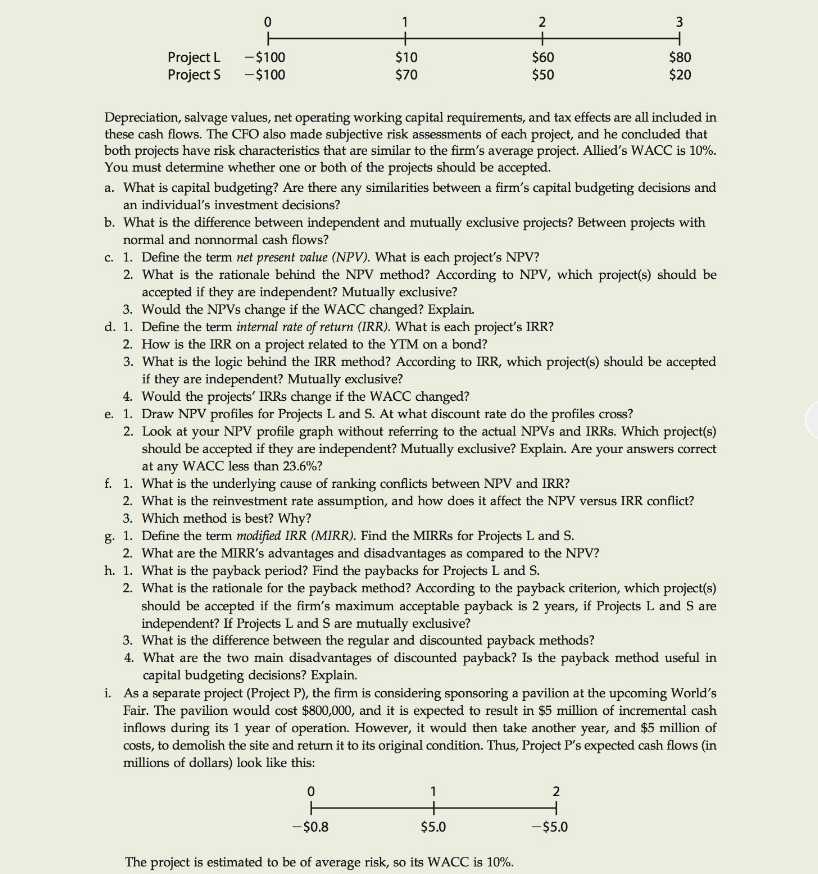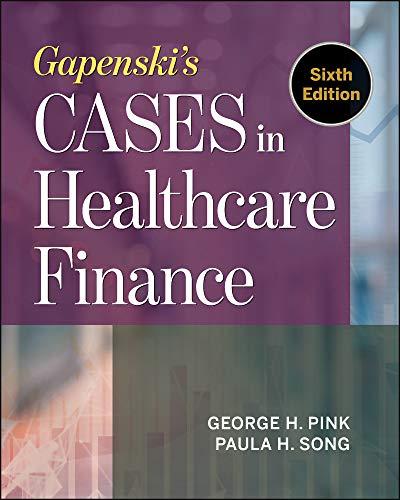Need answer from g to i .
g. 1. Define the term modified IRR (MIRR). Find the MIRRs for Projects L and S.
2. What are the MIRRs advantages and disadvantages as compared to the NPV?
h. 1. What is the payback period? Find the paybacks for Projects L and S.
2. What is the rationale for the payback method? According to the payback criterion, which project(s) should be accepted if the firms maximum acceptable payback is 2 years, if Projects L and S are independent? If Projects L and S are mutually exclusive?
3. What is the difference between the regular and discounted payback methods?
4. What are the two main disadvantages of discounted payback? Is the payback method useful in capital budgeting decisions? Explain.
i. As a separate project (Project P), the firm is considering sponsoring a pavilion at the upcoming Worlds Fair. The pavilion would cost $800,000, and it is expected to result in $5 million of incremental cash inflows during its 1 year of operation. However, it would then take another year, and $5 million of costs, to demolish the site and return it to its original condition. Thus, Project Ps expected cash flows (in millions of dollars) look like this:


2 0 1 3 -$100 -$100 $10 $60 $50 $80 $20 Project L Project S $70 Depreciation, salvage values, net operating working capital requirements, and tax effects are all included in these cash flows. The CFO also made subjective risk assessments of each project, and he concluded that both projects have risk characteristics that are similar to the firm's average project. Allied's WACC is 10% You must determine whether one or both of the projects should be accepted. a. What is capital budgeting? Are there any similarities between a firm's capital budgeting decisions and an individual's investment decisions? b. What is the difference between independent and mutually exclusive projects? Between projects with normal and nonnormal cash flows? c. 1. Define the term net present value (NPV). What is each project's NPV? 2. What is the rationale behind the NPV method? According to NPV, which project(s) should be accepted if they are independent? Mutually exclusive? 3. Would the NPVS change if the WACC changed? Explain d. 1. Define the term internal rate of return (IRR). What is each project's IRR? 2. How is the IRR project related to the YTM on a bond? on a 3. What is the logic behind the IRR method? According to IRR, which project(s) should be accepted if they are independent? Mutually exclusive? 4. Would the projects' IRRS change if the WACC changed? e. 1. Draw NPV profiles for Projects L and S. At what discount rate do the profiles cross? 2. Look at your NPV profile graph without referring to the actual NPVs and IRRS. Which project(s) should be accepted if they are independent? Mutually exclusive? Explain. Are your answers correct at any WACC less than 23.6%? f. 1. What is the underlying cause of ranking conflicts between NPV and IRR? 2. What is the reinvestment rate assumption, and how does it affect the NPV versus IRR conflict? 3. Which method is best? Why? g. 1. Define the term modified IRR (MIRR). Find the MIRRs for Projects L and S. 2. What are the MIRR's advantages and disadvantages as h. 1. What is the payback period? Find the paybacks for Projects L and S. 2. What is the rationale for the payback method? According to the payback criterion, which project(s) should be accepted if the firm's maximum acceptable payback is 2 years, if Projects L and S are independent? If Projects L and S are mutually exclusive? 3. What is the difference between the regular and discounted payback methods? 4. What are the two main disadvantages of discounted payback? Is the payback method useful in capital budgeting decisions? Explain. As a separate project (Project P), the firm is considering sponsoring a pavilion at the upcoming World's Fair. The pavilion would cost $800,000, and it is expected to result in $5 million of incremental cash inflows during its 1 year of operation. However, it would then take another year, and $5 million of costs, to demolish the site and return it to its original condition. Thus, Project P's expected cash flows (in millions of dollars) look like this: compared to the NPV? i. 0 1 2 -$5.0 -$0.8 $5.0 The project is estimated to be of average risk, so its WACC is 10% 0 1 2 $5.0 -$5.0 -$0.8 The project is estimated to be of average risk, so its WACC is 10%. 1. What is Project P's NPV? What is its IRR? Its MIRR? 2. Draw Project P's NPV profile. Does Project P have normal or nonnormal cash flows? Should this project be accepted? Explain








